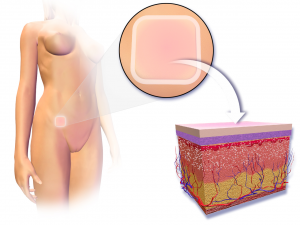For women who do not wish to become pregnant right now and are looking for more convenience and ease in preventing an unwanted pregnancy, each day, new innovative methods are being released on the market1. Among the most sought-after options at the moment for these women, at the top of the list is the contraceptive patch, also known as the transdermal patch.
Because it is totally different from conventional hormonal methods (birth control pill and hormonal injection), this method still causes many doubts and fears regarding its effectiveness. But if used correctly and under the guidance of your gynecologist, its failure rates are identical to the other methods, offering an effectiveness of 99.9%.
What is the Contraceptive Patch?
The contraceptive patch2 is a small patch, similar to an adhesive bandage, that contains the hormones estrogen and progesterone. When this small patch is in contact with the skin, it releases small daily doses of these hormones continuously into the bloodstream, working directly on ovulation to prevent eggs from being released. Besides preventing ovulation, it also makes the cervical mucus thicker, making it more difficult for sperm to reach the egg.
Since the contraceptive patch is not transparent, it should be placed in an area of the body that will be covered by clothing if you do not want it to be visible. The most recommended areas to apply the patch are: the upper buttocks, back, lower abdomen, or the outside of the arm.
Before deciding on the best contraceptive method, always talk to your gynecologist about all the options and about which is best for you, your body, and your routine. The contraceptive patch is one of the best options for women who have a busy routine and may end up forgetting to take or use contraceptive methods that need to be taken daily.
How to Use the Contraceptive Patch
If you were not using any other hormonal contraceptive method, the contraceptive patch should be applied on the first day of your period. But if you are already using the birth control pill, for example, you should apply the patch as soon as you finish the pack of pills, before your next period starts.
Choose the best place to put the patch. After selecting, peel off the upper part and apply it directly to your skin, making sure it is perfectly stuck on. The contraceptive patch should stay on the same spot on your skin for seven days; after this period, remove it and put on a new one to replace it.
This process of changing the contraceptive patch should be done for 3 weeks, totaling 21 days of use. After this period, you must take a one-week break for your period to occur. After completing this one-week break, begin the patch application process again.
If the Contraceptive Patch Comes Off, What Should I Do?
The contraceptive patch was developed and produced to adhere to the skin for a period of 7 days, but it may accidentally come off the skin or lose adhesion due to some factors. In this case, you need to replace it with a new patch immediately, making sure not to exceed 24 hours so that the method remains effective.
If more than 24 hours pass without the contraceptive patch, you will need to use another contraceptive method until you complete a week and apply a new patch. In this case, we recommend using a condom—male or female—which is temporary and can be used during all sexual intercourse3. Remember, condoms not only prevent unwanted pregnancy, but also protect men and women from sexually transmitted infections, such as STIs.
Advantages and Disadvantages of the Contraceptive Patch
Like any contraceptive method, there are advantages and disadvantages to its use. That’s why you need to know all the benefits and possible side effects before choosing a contraceptive method. Obviously, side effects are just risks, and many women use this method for many years without experiencing them. So it greatly depends on each woman’s body and how it will react to the method.
- Highly effective and safe method;
- Easy to apply and remove;
- Can be applied at home;
- No need to remember every day;
- No interruption during sexual intercourse;
- Lasts for 7 days (needs to be replaced every 7 days);
Disadvantages
- Even in more discreet areas, the patch is visible;
- It may come off or fall off over time;
- It may cause redness or an allergic reaction at the application site;
- It may cause headaches and mood changes;
- It may cause changes in the menstrual cycle;
- It may cause changes in weight;
- It does not protect against sexually transmitted infections.
Do I Have to Always Use the Patch in the Same Place?
The area you choose to apply the contraceptive patch does not always have to be the same. In fact, it’s recommended that each week you place it in a different region of the body. Try alternating between the lower abdomen, buttocks, back, and the outside of the arm. It is not recommended to use it on the breast area.
Tips to Reduce the Chance of the Contraceptive Patch Coming Off
To use your contraceptive patch correctly and reduce the chances of it coming off easily, always apply it to clean, dry skin. Never use moisturizing oils, creams, lotions, or any type of makeup on or near the area where the patch is placed. All these products may interfere with the patch’s effectiveness, causing the adhesive to lose its effect on the skin and making it come off more easily.
Photo: BruceBlaus












